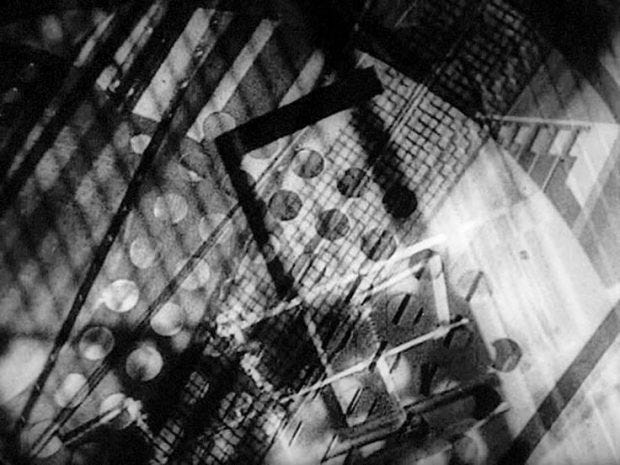There’s a reason I’m thinking about the 1930s this week — and that’s because we’ve just released a bumper 1930s-themed episode of Muub Tube (alongside special guest Eugene Kotlyarenko). You can catch it here ok.
— Something very interesting happened in 1930 — so far as experimental film goes. Europe. Pesanek’s The Light Penetrates the Dark. Ralph Steiner’s Mechanical Principles. Laszlo Moholy-Nagy’s Lightplay: black white grey. This is not to mention the ongoing work that Hans Richter was doing with his ‘rhythm’ films (whose output slowed during the decade). Then you have Alexander Hammid’s Aimless Walk (also 1930). But there are two different tendencies in tension here.
— Pesanek, Moholy-Nagy and Steiner were each — together, separately — plumbing the distorting and technical capabilities of film. So was Richter (a DaDa’ist). Their works are concerned with light, exposure, negatives, and machinery. In this, they pursue the trajectory begun by Fernand Leger with his Ballet Mecanique (1924). They are experiments in the newfangled apparatus of film. They are explorations of (and paeans to) the kinetic.
— Hammid’s Aimless Walk does something a little different. It is a confrontation with modernity, selfhood, and alienation — and also of perception. It slips through the trees of the ‘city symphony’. In its short seven minutes, we witness a man take a seemingly ‘aimless’ walk through Prague. Hammid’s camera is disorienting — cutting rapidly between the tracks of a tram on which the figure rides, pools of mud and water in the streets, spinning cutaways of rooflines and stairways. Unlike the coherent, mechanical system of the symphony film, the figure is detached — the city is out of joint (or he is out of joint with it). Sleeping workers. Perilous cranes. And — in an early figuration of his later work with Maya Deren (Meshes of the Afternoon, 1943) there is a moment of splitting-doubling (where he climbs aboard a tram, another figure — identical to him — stands on the pavement, before walking away). Later, the camera is angled down at a rippling pool of water, and we witness the blurred reflection of a man (the walking man) cross its upper quarter, diminishing slowly until he disappears.
— For Moholoy-Nagy, Pesanek, Richter and Steiner, the camera was a technical apparatus and the subject of the film. Their works are like trick boxes of effects and manipulations, but the camera is always the camera — and it is not affiliated with our own perceptive being, or our eye. We are seeing what the camera can do — as if our eye (the eye) has been evacuated from the body and the equipment of thinking-perceiving-knowing. Here is a filmography for instruments and machines.
— For Hammid, subjectivity and perception were themselves the subject of the film. Often, it is assumed we are seeing as if in point of view — a little like Cocteau’s Orphee [1950] and how it articulates a ‘first person shooter’ framing of vision. Machines exist within his world, but they are allegories and lyrical inflexions of identity – of modern subjectivity. It is less confident in the advances of the modern world (mud, soil, brackish water — an anxious figure whose subjectivity [and literal body] is divided, split), where machines occupy an ambivalent place within the terrain of the city (something more readily primordial). Here is a subject who has been pulled apart by the same twirling, shimmering machines that constitute Moholy-Nagy’s technological music — the rhythmic, pulsating gears of Steiner’s Mechanical Principles (1930).
— With the mechanical films, I was asking myself whether — were the events unfolding before me (as if on a stage) — I would perceive them any differently. Really the answer is no. There is a quite rigid barrier between the observed happening or mechanism (say, a gear moving horizontally while a piston moves vertically — or light shimmering through a kinetic structure). Hammid introduces juxtapositions and cuts — the tracery of montage and its effects. The eye itself is quizzed, problematized, and the ontological question of the film is brought into doubt (as is that of the spectator and the subject — the unnamed, ‘aimless’ man).
— Right. It’s entirely possible (if not likely) that I’m overly reducing or blurring a more complex aesthetic and historical trajectory here, but it strikes me as at least interesting that 1930 gave a real glut of experimental films, in Europe, that bear some real tensions in terms of their aesthetic and intellectual strategies. Hammid would obviously go on to work with Deren (I’ve mentioned this) — a collaboration that would, in turn, give rise to the ‘trance’ film and the mythopoesis of the American avant garde during the 1950s and 60s: a truly transformation epoch in modern filmmaking that would fully centre (and derange) the subject and the eye. Hammid’s aimless walk would go on long after 1930. You could say he walked right up the mountain with Stan Brakhage during the shooting of Dog Star Man (1961-1964) — some thirty years later. So much was about to happen.
If you liked this newsletter then please consider liking, sharing or subscribing. It’s lonely here.







